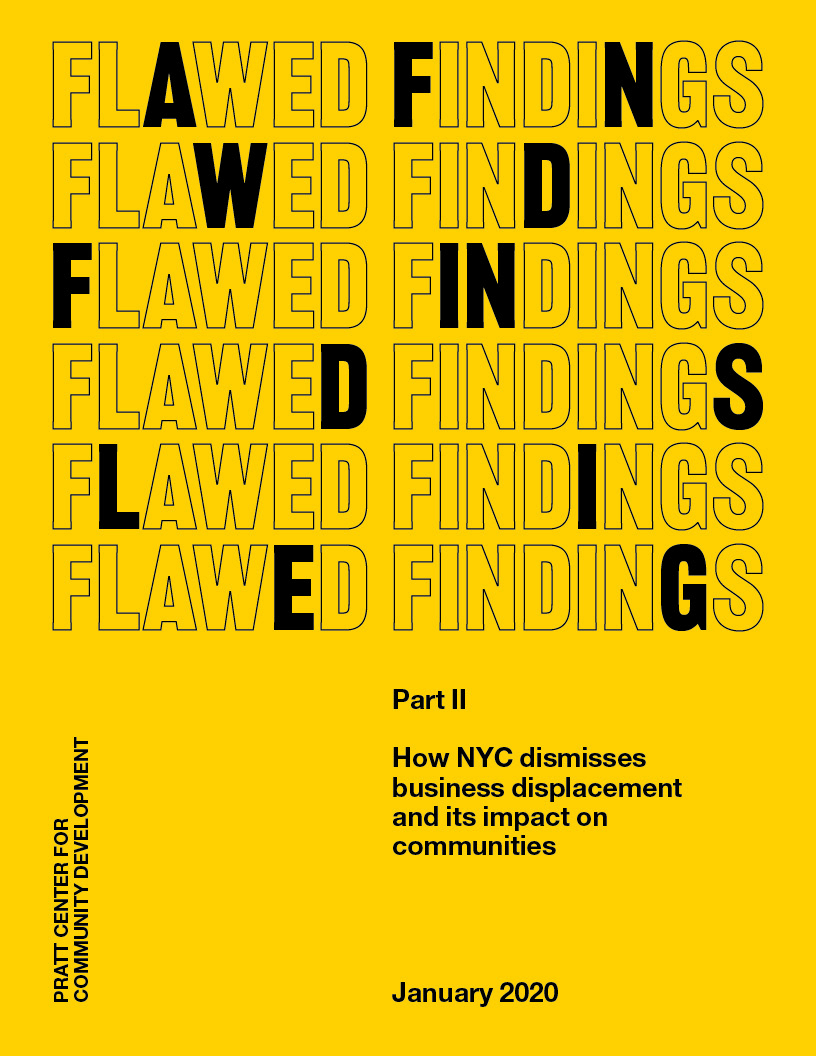
Pratt Center Research
 Democratizing Planning
Democratizing PlanningFLAWED FINDINGS PART II: How NYC Dismisses Business Displacement and its Impact on Communities
Report | January 22, 2020
This report examines the business displacement analysis portion of New York City's environmental quality review process (CEQR), which is currently the only tool the City uses to assess business displacement risk. Through an in-depth review of the CEQR Technical Manual that guides this assessment we found that it glosses over displacement pressure to such an extent that a positive finding of businesses at risk is virtually impossible. In fact, our review of 14 recent environmental review documents for major development projects spanning from 2004 to 2019, found not a single instance where the City determined there would be any significant impact on business displacement. We identified 8 flaws in the Technical Manual that allow this to happen in rezoning after rezoning, and outline a series of strategies the City should take to more effectively measure and address business displacement risk.
This report is a companion to Pratt Center's 2018 Flawed Findings Part I, which examined the City's approach to measuring residential displacement.
Background
Neighborhood businesses are critical community assets, providing essential services, employment and entrepreneurial opportunities, and creating a sense of place, familiarity and security. While the periodic opening and closing of businesses is an inescapable fact of city life, what communities find unacceptable is government intervention or public policy (or lack thereof) that leads to widespread displacement of companies that collectively form a core part of a community’s identity, provide essential goods and services to area residents and workers, or form an ecosystem that adds vitality to particular business sectors.
FINDINGS
Through a detailed review of the CEQR Technical Manual’s guidance on indirect business displacement, we identified 8 overarching flaws that break down into the following 5 main categories:
- Eroding the meaning of displacement
- Failing to regard the neighborhood by failing to describe the neighborhood
- Divorcing impact on businesses from impact on workers and economic policy
- Failing to require metrics or other substantiation for conclusions
- Ignoring potential disparate impact by race or ethnicity.
RECOMMENDATIONS
To measure and address business displacement, and to advance more informed decision-making, Pratt Center recommends the following:
- NYC should convene a Task Force of technical and economic development experts and other stakeholders to revamp the CEQR Technical Manual’s approach to evaluating business displacement.
- NYC should conduct a citywide business existing conditions analysis and use it to inform economic development policy.
- NYC should undertake and support planning for commercial and industrial districts as part of any substantial rezoning.
- NYC should assess the success and value of the myriad of business assistance and relocation programs stemming from rezonings.
Flawed Findings Part II: Business Displacement
Executive Summary DOWNLOAD>>


